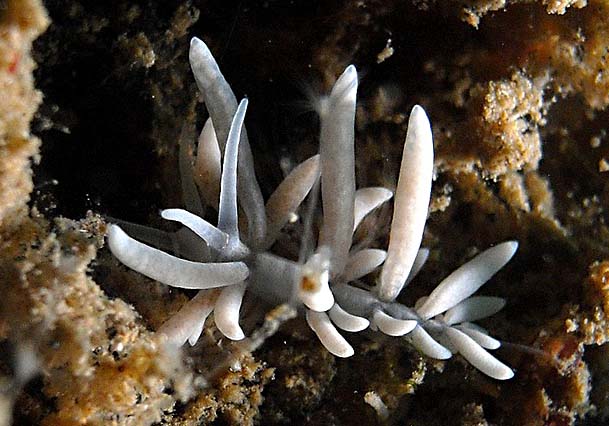This species has been observed on Mayotte Island
Body translucent white with a serie of opaque white patches on the anterior end of the head, at the base of the rhinophores, on the pericardium and along the posterior sections of the notum Cerata smooth and semicircular in cross section The anal papilla of P. pecten lies inside the second ceratal arch |

|
|
| Showing species characteristics... | Photo Fabrice Schubert |
|
See more about : Sightening and mating periods
See more about : Phyllodesmium phylogeny by Moore & Gosliner, 2009
See more about : Phyllodesmium ceratal arrangement by Rudman, 1991
See more about : Ceratal structure in Phyllodesmium by Rudman, 1991
Remarks :
Identification confirmed by Nathalie Yonow
Synonymous : (according Worms)
- No other name
| Bibliographic data :
|
 |
The length of the rhinophores in P. pecten is only two thirds of the lengh of the oral tentacles. The upper halves of the oral tentacles and rhinophores are white
The foot is approximately twice the width of the body, the leading edge of which is extended into foot corners
It is associated with octocorals of the family Xeniidae and are similar to other Xeniidae-feeding Phyllodesmium species.
References :
Bill Rudman Seaslug site : Sea Slug Forum : Phyllodesmium pecten
Nudipixel Phyllodesmium pecten
Publications :
Burghardt, I. and Wägele, H. (2004) A new solar powered species of the genus Phyllodesmium Ehrenberg, 1831 (Mollusca: Nudibranchia: Aeolidoidea) from Indonesia with analysis of its photosynthetic activity and notes on biology. Zootaxa , 596: 1-18.
Rudman, W.B. (1981) The anatomy and biology of alcyonarian-feeding aeolid opisthobranch molluscs and their development of symbiosis with zooxanthellae. Zoological Journal of the Linnean Society, 72: 219-262
Other photos of Phyllodesmium pecten :
 |
Photo Emmanuelle Aigle Mayotte, Sakouli, 10 m, 3 February 2010
|
More photos from Indian Ocean
See more about : Phyllodesmium phylogeny by Moore & Gosliner, 2009
See more about : Phyllodesmium ceratal arrangement by Rudman, 1991
See more about : Ceratal structure in Phyllodesmium by Rudman, 1991
If you have taken a photo of this species in Reunion, Mauritius or Mayotte Islands, please Contact us...